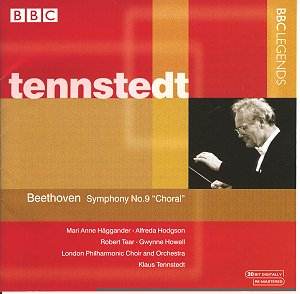I well remember hearing this performance over
the radio as it happened and being impressed by it then. A friend
who was present at the Albert Hall rang me immediately after it
was over to tell me how amazing it was live. And here it is, available
to all.
Tennstedt was a remarkable conductor, and never
less so than when caught live, as this disc amply demonstrates.
His rapport with the London Philharmonic was a miracle of its
time and it is fully in evidence here.
This Ninth is a far cry from the recent Norrington
on Hänssler . Under Tennstedt, the opening takes on an elemental,
massive quality – here is the Ur-Welt of the beginning
of Rheingold in embryo. This is a statement of the utmost
integrity, an unfolding of organic growth that is entirely true
to the spirit of Beethoven. Tennstedt and his players find astonishing
energy inherent in the harmonies, the orchestra working as one
towards its conductor’s vision.
The ‘live’ element, so visceral in evoking the
tension of the first movement, reveals less than water-tight ensemble
on several occasions in the ‘Molto vivace’ (and it is ‘molto’).
True, some detail gets lost in the acoustic, but there is no doubting
the spirit. Tennstedt takes some 17 minutes over the ‘Adagio molto
e cantabile’ (16’51: contrast Norrington’s 12’07). With Tennstedt
it becomes a gentle unfolding encompassing both grandeur and a
tenderness entirely in keeping with the composer’s Third Period.
Here one enters the near-static world of the slow movements of
the late string quartets, and to mesmeric effect. There is almost
a generosity of lyricism (and such wonderful wind playing!) that
makes the contrast at the beginning of the almighty final movement
all the more effective. Punchy and intimidating, this orchestral
shriek makes its point despite the somewhat strange recording
balance (horns, occasional split and all, shoot through the texture
rather unnaturally).
However one interprets the parade of themes (rejection
versus angry assimilation) that characterises the music pre-‘An
die Freude’ theme, the arrival of the theme itself begins a passage
of natural and inevitable growth that typifies Tennstedt’s organicist
approach. The mighty and powerful orchestral statement immediately
preceding the tenor’s entrance is the only outcome of the (true)
pianissimo cellos and double-basses at 3’.
The soloists are mixed. Howell is fine if not
overly authoritative, and Tear is Tear (overly dramatic and wobbly).
Mari Anne Häggander’s glowing high register is particularly
worthy of note. Soloists are also very closely-miked, leading
to a rather distorted sound-stage. Interpretatively, however,
the performance can hardly be faulted – perhaps the importance
of the line ‘Über sternen muss er wohnen’ is slightly underplayed,
but there is no doubt whatsoever that the rousing cheer from the
Prommers is, for once, thoroughly deserved.
Colin Clarke
